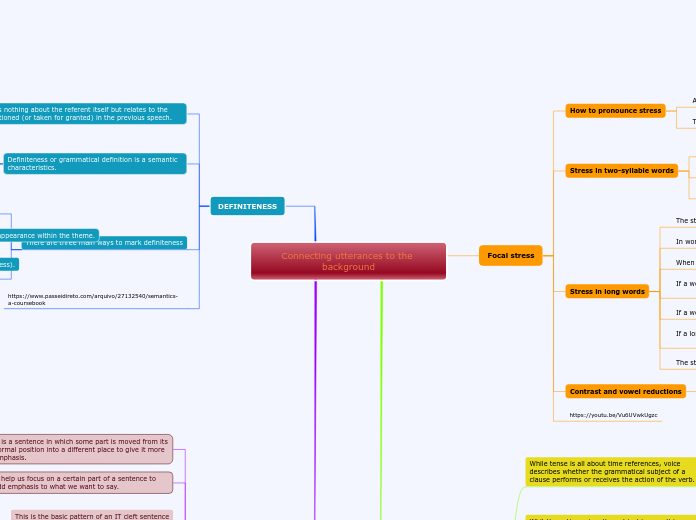Connecting utterances to the background
Focal stress
How to pronounce stress
An apostrophe shows you where the stress is, and the next syllable is the stress syllable.
The stressed syllable should be louder, a little higher, and a little longer in time.
Stress in two-syllable words
Most nouns and adjectives with two syllables have stress on the first syllable.
Most verbs have stress on the second syllable.
There are many common exceptions as hotel, exam, in nouns, and happen, finish in verbs
Stress in long words
The stressed syllable can be anywhere (at the beginning, in the middle, or at the end)
In words with four or more syllables, the stress is always in the middle, no on the first, or last syllable.
When the words end in 'tion'', 'son, 'cian', or 'ic' the stress always is on the second-last syllable.
If a word ends in 'y' and it has three or more syllables, so the stress is on two syllables before the last one.
If a word ends in 'y' and it has three syllables, so the stress is almost always on the first syllable.
If a longer word is made from a shorter root's word, then the stress is always in the same place that the root word.
The stress can move when you make a longer word from a root word.
Contrast and vowel reductions
When you pronounce the word stress, it's not just about the stressed syllable, but about the phonetic part in a word.
PASSIVE
While tense is all about time references, voice describes whether the grammatical subject of a clause performs or receives the action of the verb.
In a passive voice construction, the grammatical subject of the clause receives the action of the verb.
It becomes a prepositional phrase that tells you who the performer of the action is, but it’s no longer the grammatical subject.
A passive voice construction can even drop him from the sentence entirely.
e.g. The ball was kicked.
Whit the active voice, the subject is something, or it does the action of the verb in the sentence.
The formula for the active voice: [subject]+[verb (performed by the subject)]+[optional object]
e.g. hester kicked the ball.
With the passive voice, the subject is acted upon by some other performer of the verb.
The formula: [subject]+[some form of the verb to be]+[past participle of a transitive verb]+[optional prepositional phrase]
e.g. The ball was kicked by Chester.
• The passive voice isn’t a grammatical error; it’s a matter of style
• Use the active voice if it makes your sentence sound clearer and more natural
• Forming passive voice requires the verb “to be” and a past participle
• The passive voice is your friend when the thing receiving an action is the important part of the sentence—especially in scientific and legal contexts, times when the performer of an action is unknown, or cases where the subject is distracting or irrelevant
• When it comes to good writing, don’t be passive—even if your sentences sometimes need to be
DEFINITENESS
The definition of a reference expression, tells us nothing about the referent itself but relates to the question of whether the referent has been mentioned (or taken for granted) in the previous speech.
Definiteness or grammatical definition is a semantic characteristics.
That occurs in many languages in the noun, the adjective, and the pronoun.
That refers to whether the word that expresses the referent defines it univocally or not.
The grammar definition has two possible values [+ definite] and [- definite].
There are three main ways to mark definiteness
Explicit marking, usually by means of a definite article that is usually a clitic or an affix.
Non-explicit marking, usually resorting to syntactic procedures such as the order of constituents, or the appearance within the theme.
Complex marking, in this case, two different grammatical functions are used to indicate a third (definiteness).
CLEFTS SENTENCES
It is a sentence in which some part is moved from its normal position into a different place to give it more emphasis.
To separate into two
Specially usefull in writing
It help us focus on a certain part of a sentence to add emphasis to what we want to say.
A sentence that emphasizes an idea by focusing on a certain part af the sentence.
This is the basic pattern of an IT cleft sentence
It + be verb + subject, object, etc
+ that/who relative clause
e.g. – Joe ate the cake.
– It was Joe who ate the cake.
Pseudo-Cleft
The emphasis (focus) is usually at the end of the sentence.
e.g. – What do you need?
– What I need is something to drink.
This is the basic structure of a WH (pseudo) cleft sentence
What clause + be verb + emphasized word or phrase
